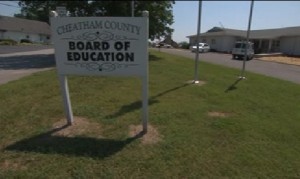![]()
When a small town school fails under No child Left Behind, it affects more than just those students. It can leave an entire community scrambling to deal with the implications.
For one thing, many rural school districts have so few schools that if one fails, there is not another choice for students to attend—even though federal law requires school districts to offer a choice to parents at failing schools.
That’s an example of the unique challenges for rural and small town school districts under NCLB, according to Dr. Tim Webb, director of Cheatham County Schools in Tennessee. Webb is becoming an outspoken advocate for rural districts like his in the cacophony of requests for waivers from states that want out of the federal education program.
In the most recent NCLB report for Tennessee, Cheatham County has twice as many schools on the list that did not meet standards. That translates to six schools in a district that has only 13 schools total and a student population of 6,800—less than one-tenth the size of Nashville Public Schools about 30 miles away.
Webb says the definition of a failing school is the same for rural counties, but the impact is much different.
“It becomes a personal issue… because they went to school there and it was good enough for them and now we’re saying it’s not,” says Webb. “Most of the public schools in rural environments are very community oriented. They’re community schools, they belong to the community. So when they start to get negative marks, it becomes difficult to maintain morale and keep folks focused on our core mission.”
Webb says it also becomes difficult to change attitudes and behavior rooted in rural and small-town culture.
“The rural environments have traditionally been agrarian… folks working in the factories for 30 years and staying here and settling. We’ve always considered  state average to be good enough. That’s the target to which we aim. The challenge now is that when we realize that if the state is 44th, 45th– state average is not a place to be aiming.”
state average to be good enough. That’s the target to which we aim. The challenge now is that when we realize that if the state is 44th, 45th– state average is not a place to be aiming.”
It seems the equation for NCLB does not account for what happens in rural school districts, according to Claire Smrekar, associate professor of public policy and education at Peabody College of Vanderbilt University.
“They don’t have the number of kids, therefore they don’t have the number of schools, therefore they have far fewer options,” says Smrekar. “So if we think beyond school district and think about what we can do in terms of geography and new pathways for parents to make better choices, that would go along way in supporting rural schools as well.”
Smrekar is also a researcher for the National Center on School Choice and has looked at unique approaches to dealing with a lack of choice in areas with failing

schools. One concept is an interdistrict open enrollment partnership to provide more options for rural and small town schools. In other words, two nearby school districts agree to ignore the usual boundaries of a student’s home district in order to provide parents choices within a broader regional area.
Such an effort is now underway in Omaha, Nebraska, which has a mandatory interdistrict student enrollment policy for public schools. Education officials there have created a regional partnership of 11 school districts that gives parents and students many more choices of schools within that broader geographical area. The intent is to address low-performing schools as well as combat increasing segregation in the school districts. (Click here for a report on a study of the Omaha interdistrict plan.)
Smrekar says the key to success for such efforts is mutual support between the school districts involved, which means each has to realize some benefits.
“There must be some federal incentives, some federal supports that go along with that kind of option to provide transportation, information to parents who may not be plugged into the channels of information that other parents are… and incentivizing this kind of arrangement,” says Smrekar.
“Thinking very deeply about what school district lines might be transferrable, what school districts lines would provide a pathway from moving kids from failing schools into schools that are thriving.”
Back in Cheatham County, Tim Webb only has the options within his existing school district boundaries. So, he has come up with some ideas of his own to improve school performance. This school year, Webb launced a 5-year improvement plan that includes bold steps like:
1. Ending Advanced Placement or AP courses (due to weak performance on the AP exams)
2. Offering dual-enrollment: high school students earn college credit through a partnership with Nashville State Community College
3. Learning plans for each student using digital technology to track and analyze progress
4. Recruiting teachers from non-traditional training programs, like Teach for America
5. A 5-step plan to improve test scores and academic benchmarks in 3rd, 8th, and 11thgrades
Webb says one tool he’s missing is more time. Like a growing number of school officials, he believes the deadline for No Child Left Behind of 2014 is too tight. That’s why he supports the request by Tennessee for a waiver in the federal program and pushing the timeline to at least 2018.
“We don’t want to step away from those standards but give us more time,” says Webb. “2014 is not a realistic deadline if here in 2010 we changed the whole ballgame. We moved the goal way on down the field but we still have the same timeline. “
Federal officials are starting to agree. U.S. Education Secretary Arne Duncan says Tennessee’s commitment to tougher standards—like those in Cheatham County– is a plus as he decides which states to give waivers for No child Left Behind.
And in late September, President Obama announced his support for allowing states to request exemption from some requirements of NCLB if they meet certain conditions.